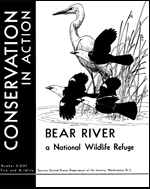United States Fish and Wildlife Service

United States Fish and Wildlife Service: Publications
Date of this Version
2007
Abstract
Previous work by the U.S. Fish and Wildlife Service identified nutrients, elemental contaminants, algal toxins, bacterial pathogens, and hormones as contaminants of concern (COCs) associated with wetlands created from the secondary effluent of a large swine concentrated animal feeding operation. In this follow-up study, COC exposure and effects to waterfowl were evaluated using game farm mallards. Mallards were kept in enclosures built on two created wetlands (treatment sites) and two reference wetlands that are federally managed for waterfowl habitat. Water quality in the created wetland enclosures had higher specific conductivity, BOD, turbidity, pH, and nutrients than reference wetlands. Algal blooms frequently occurred in the created wetlands and included Microcystis spp. All sentinel mallards tested negative for duck plague and avian influenza; however, an avian botulism outbreak on the created wetlands occurred in August of 2003 after the study was completed. Cumulative stress from poor water quality and reproduction may have caused hen mortality in the created wetland enclosures, resulting in a greater survival to hatch in the reference wetlands compared to created wetlands. However, wild brood production was observed in the created wetlands. There were no significant differences in sentinel mallard blood plasma chemistry and histology biomarkers between reference and created wetland enclosures. Known toxicity thresholds were only exceeded for selenium concentrations in liver, and included sentinel mallards on reference and created wetland enclosures. It is recommended that a constructed wetland system is developed to further treat Hastings Pork secondary swine wastewater before it is delivered to habitat wetlands for migratory waterfowl.


Comments
Published by the U.S. Fish and Wildlife Service, 1-84, (2007)